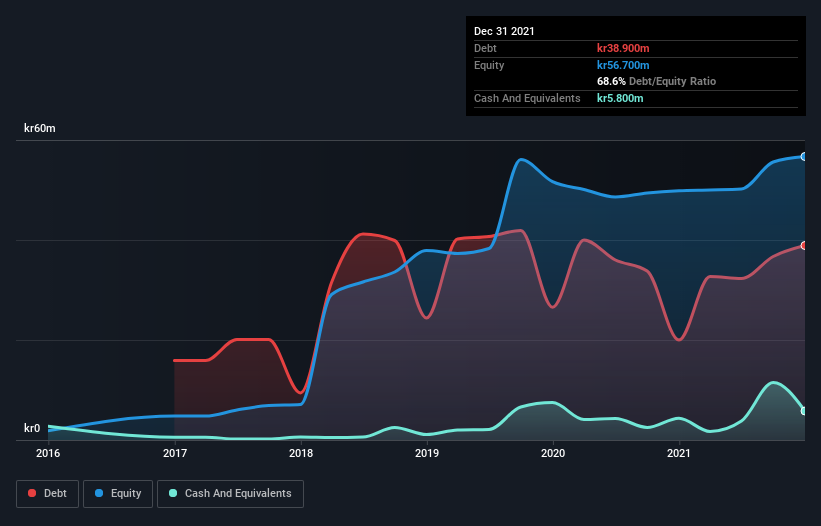
Some say volatility, rather than debt, is the best way to think about risk as an investor, but Warren Buffett famously said that 'Volatility is far from synonymous with risk.' When we think about how risky a company is, we always like to look at its use of debt, since debt overload can lead to ruin. Importantly, Hedera Group AB (publ) (STO:HEGR) does carry debt. But the real question is whether this debt is making the company risky.
When Is Debt A Problem?
Debt is a tool to help businesses grow, but if a business is incapable of paying off its lenders, then it exists at their mercy. Ultimately, if the company can't fulfill its legal obligations to repay debt, shareholders could walk away with nothing. While that is not too common, we often do see indebted companies permanently diluting shareholders because lenders force them to raise capital at a distressed price. Having said that, the most common situation is where a company manages its debt reasonably well - and to its own advantage. The first step when considering a company's debt levels is to consider its cash and debt together.
View our latest analysis for Hedera Group
What Is Hedera Group's Net Debt?
You can click the graphic below for the historical numbers, but it shows that as of December 2021 Hedera Group had kr38.9m of debt, an increase on kr20.0m, over one year. However, it does have kr5.80m in cash offsetting this, leading to net debt of about kr33.1m.

How Healthy Is Hedera Group's Balance Sheet?
Zooming in on the latest balance sheet data, we can see that Hedera Group had liabilities of kr55.7m due within 12 months and liabilities of kr34.7m due beyond that. Offsetting these obligations, it had cash of kr5.80m as well as receivables valued at kr28.4m due within 12 months. So its liabilities total kr56.2m more than the combination of its cash and short-term receivables.
This is a mountain of leverage relative to its market capitalization of kr57.3m. Should its lenders demand that it shore up the balance sheet, shareholders would likely face severe dilution.
We use two main ratios to inform us about debt levels relative to earnings. The first is net debt divided by earnings before interest, tax, depreciation, and amortization (EBITDA), while the second is how many times its earnings before interest and tax (EBIT) covers its interest expense (or its interest cover, for short). Thus we consider debt relative to earnings both with and without depreciation and amortization expenses.
Hedera Group has a debt to EBITDA ratio of 4.7 and its EBIT covered its interest expense 2.9 times. This suggests that while the debt levels are significant, we'd stop short of calling them problematic. However, it should be some comfort for shareholders to recall that Hedera Group actually grew its EBIT by a hefty 11,650%, over the last 12 months. If that earnings trend continues it will make its debt load much more manageable in the future. When analysing debt levels, the balance sheet is the obvious place to start. But you can't view debt in total isolation; since Hedera Group will need earnings to service that debt. So if you're keen to discover more about its earnings, it might be worth checking out this graph of its long term earnings trend.
But our final consideration is also important, because a company cannot pay debt with paper profits; it needs cold hard cash. So it's worth checking how much of that EBIT is backed by free cash flow. Happily for any shareholders, Hedera Group actually produced more free cash flow than EBIT over the last two years. That sort of strong cash generation warms our hearts like a puppy in a bumblebee suit.
Our View
Hedera Group's conversion of EBIT to free cash flow was a real positive on this analysis, as was its EBIT growth rate. But truth be told its net debt to EBITDA had us nibbling our nails. We would also note that Healthcare industry companies like Hedera Group commonly do use debt without problems. Considering this range of data points, we think Hedera Group is in a good position to manage its debt levels. Having said that, the load is sufficiently heavy that we would recommend any shareholders keep a close eye on it. When analysing debt levels, the balance sheet is the obvious place to start. However, not all investment risk resides within the balance sheet - far from it. To that end, you should learn about the 5 warning signs we've spotted with Hedera Group (including 3 which make us uncomfortable) .
Of course, if you're the type of investor who prefers buying stocks without the burden of debt, then don't hesitate to discover our exclusive list of net cash growth stocks, today.
Valuation is complex, but we're here to simplify it.
Discover if Hedera Group might be undervalued or overvalued with our detailed analysis, featuring fair value estimates, potential risks, dividends, insider trades, and its financial condition.
Access Free AnalysisHave feedback on this article? Concerned about the content? Get in touch with us directly. Alternatively, email editorial-team (at) simplywallst.com.
This article by Simply Wall St is general in nature. We provide commentary based on historical data and analyst forecasts only using an unbiased methodology and our articles are not intended to be financial advice. It does not constitute a recommendation to buy or sell any stock, and does not take account of your objectives, or your financial situation. We aim to bring you long-term focused analysis driven by fundamental data. Note that our analysis may not factor in the latest price-sensitive company announcements or qualitative material. Simply Wall St has no position in any stocks mentioned.
About OM:HEGR
Hedera Group
Provides personal assistance, staffing, and recruitment services for healthcare and social care sectors in Sweden.
Mediocre balance sheet and slightly overvalued.
Market Insights
Community Narratives



